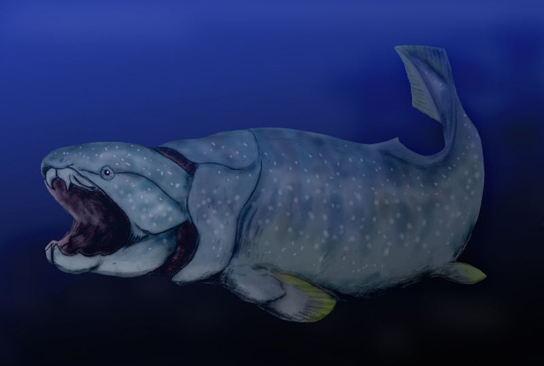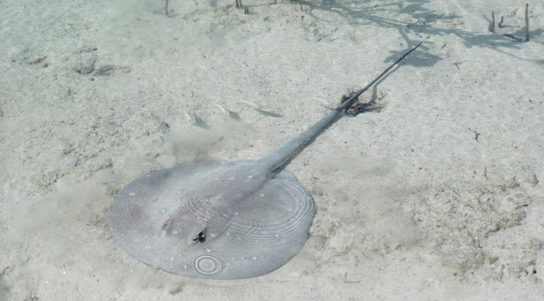15.8: Jawed Fishes
- Page ID
- 44067
Gnathostomes or “jaw-mouths” are vertebrates that possess jaws. One of the most significant developments in early vertebrate evolution was the development of the jaw, which is a hinged structure attached to the cranium that allows an animal to grasp and tear its food. The evolution of jaws allowed early gnathostomes to exploit food resources that were unavailable to jawless fishes.

Early gnathostomes also possessed two sets of paired fins, allowing the fishes to maneuver accurately. Pectoral fins are typically located on the anterior body, and pelvic fins on the posterior. Evolution of the jaw and paired fins permitted gnathostomes to expand from the sedentary suspension feeding of jawless fishes to become mobile predators. The ability of gnathostomes to exploit new nutrient sources likely is one reason that they replaced most jawless fishes during the Devonian period. Two early groups of gnathostomes were the acanthodians and placoderms (Figure 1), which arose in the late Silurian period and are now extinct. Most modern fishes are gnathostomes that belong to the clades Chondrichthyes and Osteichthyes.
Chondrichthyes: Cartilaginous Fishes
The clade Chondrichthyes is diverse, consisting of sharks (Figure 2), rays, and skates, together with sawfishes and a few dozen species of fishes called chimaeras, or “ghost” sharks.” Chondrichthyes are jawed fishes that possess paired fins and a skeleton made of cartilage. This clade arose approximately 370 million years ago in the early or middle Devonian. They are thought to be descended from the placoderms, which had skeletons made of bone; thus, the cartilaginous skeleton of Chondrichthyes is a later development. Parts of shark skeleton are strengthened by granules of calcium carbonate, but this is not the same as bone.

Most cartilaginous fishes live in marine habitats, with a few species living in fresh water for a part or all of their lives. Most sharks are carnivores that feed on live prey, either swallowing it whole or using their jaws and teeth to tear it into smaller pieces. Shark teeth likely evolved from the jagged scales that cover their skin, called placoid scales. Some species of sharks and rays are suspension feeders that feed on plankton.
Sharks have well-developed sense organs that aid them in locating prey, including a keen sense of smell and electroreception, with the latter perhaps the most sensitive of any animal. Organs called ampullae of Lorenzini allow sharks to detect the electromagnetic fields that are produced by all living things, including their prey. Electroreception has only been observed in aquatic or amphibious animals. Sharks, together with most fishes and aquatic and larval amphibians, also have a sense organ called the lateral line, which is used to detect movement and vibration in the surrounding water, and is often considered homologous to “hearing” in terrestrial vertebrates. The lateral line is visible as a darker stripe that runs along the length of a fish’s body.

Sharks reproduce sexually, and eggs are fertilized internally. Most species are ovoviviparous: The fertilized egg is retained in the oviduct of the mother’s body and the embryo is nourished by the egg yolk. The eggs hatch in the uterus, and young are born alive and fully functional. Some species of sharks are oviparous: They lay eggs that hatch outside of the mother’s body.
Embryos are protected by a shark egg case or “mermaid’s purse” (Figure 3) that has the consistency of leather. The shark egg case has tentacles that snag in seaweed and give the newborn shark cover. A few species of sharks are viviparous: The young develop within the mother’s body and she gives live birth.

Rays and skates comprise more than 500 species and are closely related to sharks. They can be distinguished from sharks by their flattened bodies, pectoral fins that are enlarged and fused to the head, and gill slits on their ventral surface (Figure 4). Like sharks, rays and skates have a cartilaginous skeleton. Most species are marine and live on the sea floor, with nearly a worldwide distribution.
Osteichthyes: Bony Fishes
Members of the clade Osteichthyes, also called bony fishes, are characterized by a bony skeleton. The vast majority of present-day fishes belong to this group, which consists of approximately 30,000 species, making it the largest class of vertebrates in existence today.
Nearly all bony fishes have an ossified skeleton with specialized bone cells (osteocytes) that produce and maintain a calcium phosphate matrix. This characteristic has only reversed in a few groups of Osteichthyes, such as sturgeons and paddlefish, which have primarily cartilaginous skeletons. The skin of bony fishes is often covered by overlapping scales, and glands in the skin secrete mucus that reduces drag when swimming and aids the fish in osmoregulation. Like sharks, bony fishes have a lateral line system that detects vibrations in water.
All bony fishes use gills to breathe. Water is drawn over gills that are located in chambers covered and ventilated by a protective, muscular flap called the operculum. Many bony fishes also have a swim bladder, a gas-filled organ that helps to control the buoyancy of the fish. Bony fishes are further divided into two extant clades: Actinopterygii (ray-finned fishes) and Sarcopterygii (lobe-finned fishes).
Actinopterygii, the ray-finned fishes, include many familiar fishes—tuna, bass, trout, and salmon (Figure 5a), among others. Ray-finned fishes are named for their fins that are webs of skin supported by bony spines called rays. In contrast, the fins of Sarcopterygii are fleshy and lobed, supported by bone (Figure 5b). Living members of this clade include the less-familiar lungfishes and coelacanths.

Contributors and Attributions
- Biology. Provided by: OpenStax CNX. Located at: http://cnx.org/contents/185cbf87-c72e-48f5-b51e-f14f21b5eabd@10.8. License: CC BY: Attribution. License Terms: Download for free at http://cnx.org/contents/185cbf87-c72...f21b5eabd@10.8

